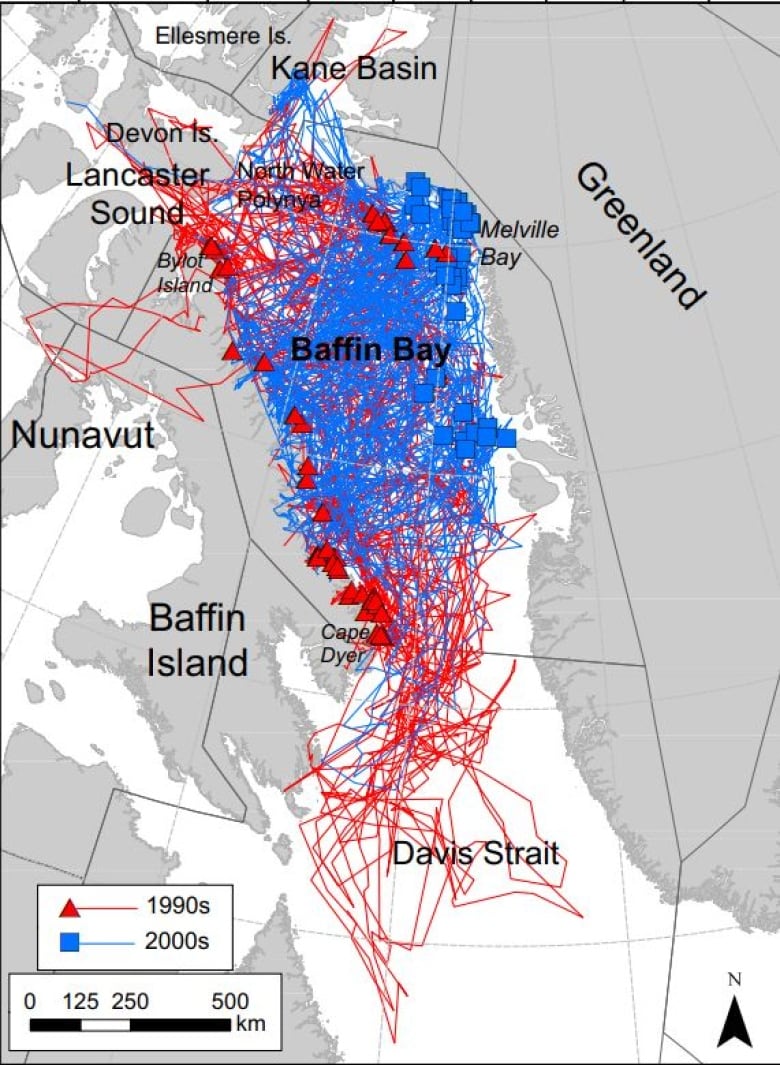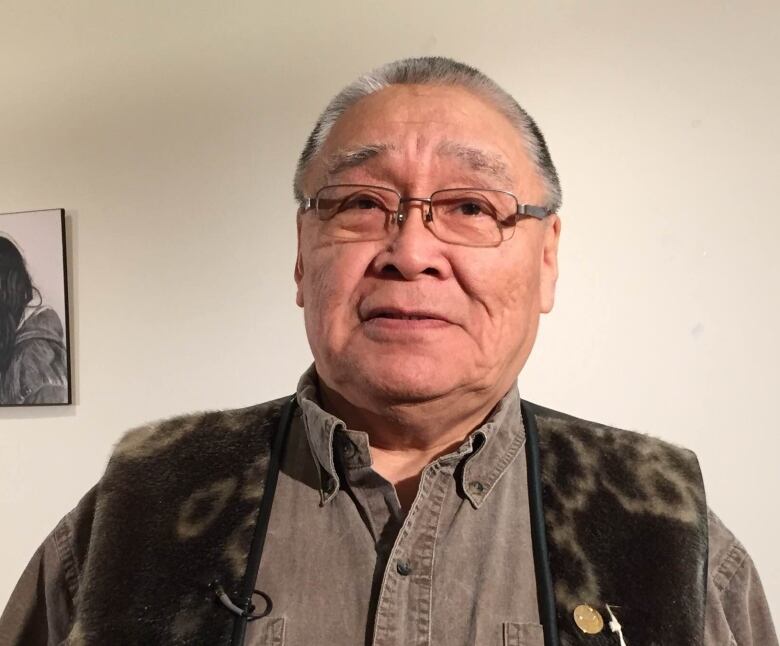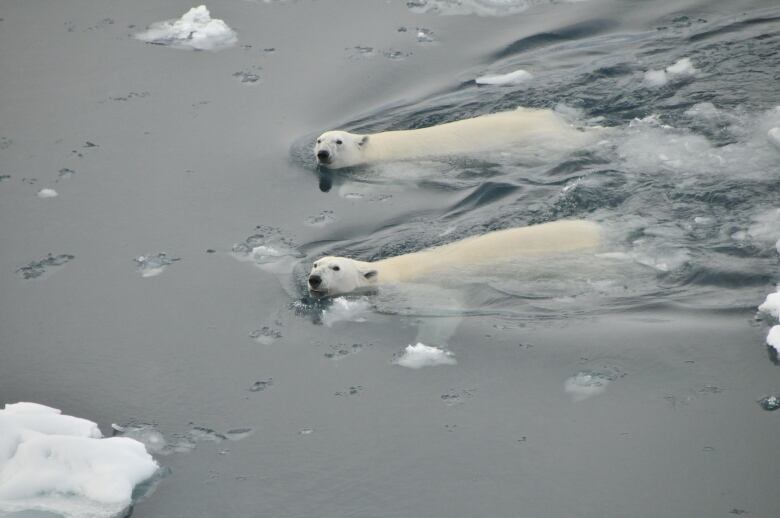It's no surprise for Inuit Baffin Bay polar bears defy past assumptions with stable population
Declining sea ice in region a threat, but sustainable hunt possible, say biologists

The polar bears of Baffin Bay are tremendous travellers: they cross the ice-covered water between Baffin Island, Nunavut, and Greenland,tracingcoastlines that can cover tens of thousands of square kilometres. They feast on fat seals as they go, and make babies along the way.
But something is constantly changing for the bears: their environment.
According toa recent study published in the journal Ecological Applications, on average since the 1990s, the bears have beenspending less time on the iceevery year, and more time on land. In the 2000sspecifically, they spent 90 days on land instead of 60.
On land, Baffin Bay polar bears are in a dietary holding pattern. Each bear is in a fast until the sea ice returns. The study finds that more time on land correlates with skinnier bears and a decline in reproductive productivity.
"When bears spend more time on land, they have less time on the sea ice to hunt seals and they have to rely on their fat stores," said Kristin Laidre, a marine biologist at the University of Washington and the lead author of the study, in a telephone interview.
"So we see declines in body condition of bears basically fatness of bears and then that body condition can translate to reproduction," Laidre said. "We actually see smaller litter sizes for mothers when they have less time on the sea ice."

According to the study, the extra time on land aligns with a decades long decline in seasonal sea ice cover in the region that period of time between winter freeze up and spring meltin Baffin Bay.
Global warming models predict seasonal sea ice in Baffin Bay will continue to decline. And over the next three generations of bears (about 35 years), the Baffin Bay polar bear population is expected to mirror this decline, through reduced body size, reduced litters, andpossiblyreduced numbers.
"The loss of sea ice across the Arctic is the number one conservation concern for polar bears globally," Laidre said.
Science aligns withInuit knowledge: Researcher
But for now, researchers say the Baffin Bay polar bear population is relatively abundant, something that comes as no surprise to Inuit in the region who have lived with the bears for thousands of years
The Baffin Bay polar bears inhabit approximately one million square kilometres of land and sea encompassing Baffin Bay, and portions of Baffin Island, all of Bylot Sound, and parts of west and northwest Greenland.
Their population is stable at about 2,800 animals, and appears to have been stable for a while. This population estimate was not a direct result of Laidre's study, but was included in the report's research.
Previous estimates of the Baffin Bay population pegged it at about 2,100 animals.

Inuit in the region have long argued that the Baffin Bay polar bear population was healthy, and maybe even growing. They have been making that argument, based on their observations, against the science of the day for at least 10 years.
"The Inuit did not support the science that was presented during public hearings in 2007 and 2008," said James Eetoolook, vice president of Nunavut Tunngavik Inc., the Inuit organization responsible for guarding the obligations and rights contained in Nunavut Agreement, in a phone call.
Those hearings blamed a supposed decline in the polar bear population on overhunting, saying the combined hunt in Greenland and Nunavut was not sustainable.
"Instead of the predicted decrease in the number of polar bears science has confirmed what the Inuit have stated, that the population has increased."
Previous estimates of the Baffin Bay population pegged it at about 2,100 animals.
Stephen Atkinson, one of the study's co-authors, and now a contract wildlife biologist who has spent close to 30 years studying polar bears, cautioned against comparing the latest population estimate with the earlier. The two studies were designed differently, he said.
But he said the latest findings do back up what many Inuit were saying all along that the population has not declined below what it was thought to be earlier.
"The findings were quite consistent with what people were seeing on the ground in Baffin Bay," he said.

Maintaining a healthy population
Polar bears are a universal symbol of the North.But for the Inuit, Eetoolook saidthey are food, clothing, a source of income for hunters, and dangerous predators who keep Inuit on constant alert.
"Polar bears are wild animals, and very vicious animals, and unpredictable animals," Eetoolook said. "They can attack anytime."
In 2018-19, 439 bears were harvested in Nunavut, with 73 of them from the Baffin Bay population. Both numbers are below the total annual allowable harvest.
The governments of Nunavut and Greenland co-manage the Baffin Bay bear population, and agreed to an increased quota of 160 bears based on the 2017 harvest assessment for the Baffin Bay and Kane Basin Polar Bear Subpopulations. That quota is split evenly between hunters in the two jurisdictions.
Eetoolook said the increased harvest was welcomed by Inuit, not only for cultural and safety reasons, but because hunters keep the population healthy in the long run.
"The population shows that it is sustainable at that number," Eetoolook said. "The population can stay healthy."
There are many ways for a polar bear to die, but a hunter's bullet may be one of the best ways to go. Atkinson, who was a co-author of the 2017 harvest assessment report, said Inuit hunting through a well-managed harvesting program can help keep the polar bear population healthy by culling it in times of bearover-abundance.
"The population is at its most productive when the density or the abundance of that population is slightly below the maximum number [the] environment can support," Atkinson said.
Even now, when data suggests the bears of Baffin Bay may be in a transition state between abundance and decline, hunting can help keep the population healthy.
"It is possible to harvest a population [of polar bears] even when it is undergoing changes as a result of climate change," he said.

But the animals do rely on Arctic sea ice. Changes to the latter are bound to impact the bears.
"One of the things to keep in mind is that climate change and harvesting to some extent are separate issues," Atkinson said. "Nothing that we do, or what is done in terms of harvesting, is going to change the fact that the environment within Baffin Bay is changing.
"Those changes are and will continue to induce changes in the Baffin Bay polar bear population."
Managing the hunt
The Inuit can manage the polar bear hunt in light of environmental changes as they develop, says Markus Dyck, the polar bear specialist for the government of Nunavut, and also a co-author onLaidre's polar bear study.
Dyck has been studying the bears since the 90s and has spent the better part of 20 years in Nunavut.

He said the territorial government, Inuit organizations, researchers, and Inuit hunters work together to closely monitor changes in bear condition and population. Worst-case scenarios of over-hunting are easy to imagine, but unlikely to develop, because the population is closely monitored by those who live with the bears everyday.
"If there's a change in reproductive rates, then there will be new decisions made on what the harvest rates are," Dyck said.
"When hunters observe something that is of critical concern if they say, 'Our bears are getting very skinny,' or 'We can't find many males,' or 'There are no females with offspring around' this information comes back to the government."
For Dyck it almost seems too obvious to say: a decline in the bear's environment over time will affect the bear.The important observation to make is that the polar bear hunt is managed carefully by everyone involved.
"There's a constant feedback loop from the communities, from the hunters, from the people who are actually on the ground and harvesting.
"Polar bears are still a very, very high priority in Nunavut," Dyck said.
Corrections
- Due to an editing error, an earlier version of this story mistakenly attributed statements from Stephen Atkinson with statements from James Eetoolook.Mar 03, 2020 9:38 AM CT












_(720p).jpg)


 OFFICIAL HD MUSIC VIDEO.jpg)
.jpg)



























































































